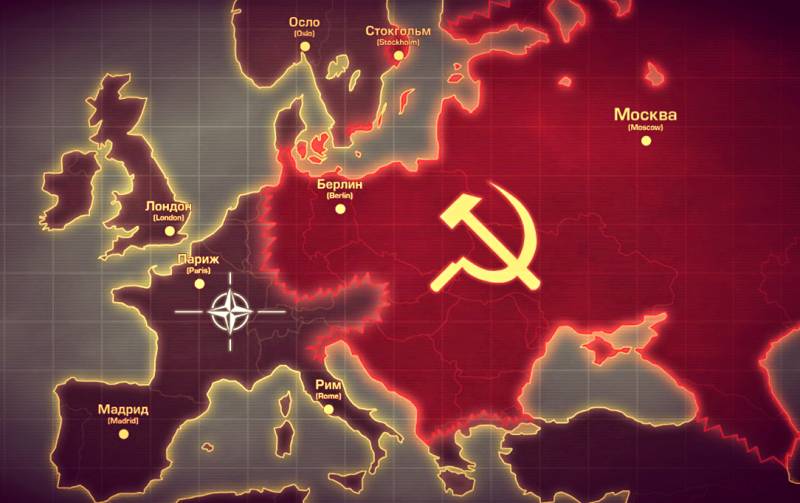A brilliant example of foreign policy: why did the USSR try to become a member of NATO
The NATO bloc is celebrating the XNUMXth anniversary of its founding the other day. This military alliance is the main danger to our country in the western direction. Sometimes you can hear, on a humorous basis, Russia's proposal to join NATO itself, removing the external threat from within. The most interesting thing is that the USSR has already applied for admission to the North Atlantic alliance five years after its founding. Why did the Soviet leadership take that step, and why did the Kremlin then refuse?
NATO was created in 1949, and it included all the countries of the anti-Hitler coalition. Except the USSR. The anti-Soviet orientation of the alliance was not even hidden, as evidenced by the saying of the first general secretary of the Ismey bloc:
So why did Moscow itself decide to enter the close ranks of its enemies? The then leaders of the country can hardly be blamed for naivety and shortsightedness. Nevertheless, the USSR Ministry of Foreign Affairs sent a note at the end of March 1954 to the governments of the United States, France and Great Britain with a request for the admission of the Soviet Union to NATO. In this case, the bloc would cease to have an anti-Soviet orientation, and a system of pan-European collective security could be formed. However, in Washington, this proposal was rejected.
The United States of America, in principle, can be understood. After the end of World War II, the Soviet Union had the strongest land army on the planet, which, if necessary, could pass Europe as a knife through the oil to the English Channel. As of 1954, the USSR would dominate the North Atlantic Alliance, leaving Washington out of work. The United States had only one “super argument” in the form of atomic weapons, successfully tested in Japanese cities. But Moscow was able to acquire its own atomic bomb with incredible speed.
The Soviet leadership was “offended” by NATO’s expected rejection, but gracefully benefited from it. Moscow officially recorded the duplicity of the West, which verbally sought to detente, but in fact built a military bloc directed against the USSR. Subsequently, the North Atlantic Alliance accepted the FRG into its membership, making it extremely cynical on May 9, 1955. The Kremlin responded by creating the Warsaw Pact, which was signed only 5 days later, on May 14, 1955.
In addition to the USSR, the Organization included the GDR, Poland, Romania, Albania, Hungary, Bulgaria and Czechoslovakia. The general armed forces of the socialist bloc numbered then seven and a half million troops. So officially for many decades a bipolar world was secured, which guaranteed security in Europe.
The application of the USSR for joining NATO is, without exaggeration, a brilliant example of Soviet foreign policy.
NATO was created in 1949, and it included all the countries of the anti-Hitler coalition. Except the USSR. The anti-Soviet orientation of the alliance was not even hidden, as evidenced by the saying of the first general secretary of the Ismey bloc:
Keeping Russians outside Europe, Americans in Europe, and Germans under European control.
So why did Moscow itself decide to enter the close ranks of its enemies? The then leaders of the country can hardly be blamed for naivety and shortsightedness. Nevertheless, the USSR Ministry of Foreign Affairs sent a note at the end of March 1954 to the governments of the United States, France and Great Britain with a request for the admission of the Soviet Union to NATO. In this case, the bloc would cease to have an anti-Soviet orientation, and a system of pan-European collective security could be formed. However, in Washington, this proposal was rejected.
The United States of America, in principle, can be understood. After the end of World War II, the Soviet Union had the strongest land army on the planet, which, if necessary, could pass Europe as a knife through the oil to the English Channel. As of 1954, the USSR would dominate the North Atlantic Alliance, leaving Washington out of work. The United States had only one “super argument” in the form of atomic weapons, successfully tested in Japanese cities. But Moscow was able to acquire its own atomic bomb with incredible speed.
The Soviet leadership was “offended” by NATO’s expected rejection, but gracefully benefited from it. Moscow officially recorded the duplicity of the West, which verbally sought to detente, but in fact built a military bloc directed against the USSR. Subsequently, the North Atlantic Alliance accepted the FRG into its membership, making it extremely cynical on May 9, 1955. The Kremlin responded by creating the Warsaw Pact, which was signed only 5 days later, on May 14, 1955.
In addition to the USSR, the Organization included the GDR, Poland, Romania, Albania, Hungary, Bulgaria and Czechoslovakia. The general armed forces of the socialist bloc numbered then seven and a half million troops. So officially for many decades a bipolar world was secured, which guaranteed security in Europe.
The application of the USSR for joining NATO is, without exaggeration, a brilliant example of Soviet foreign policy.

Information